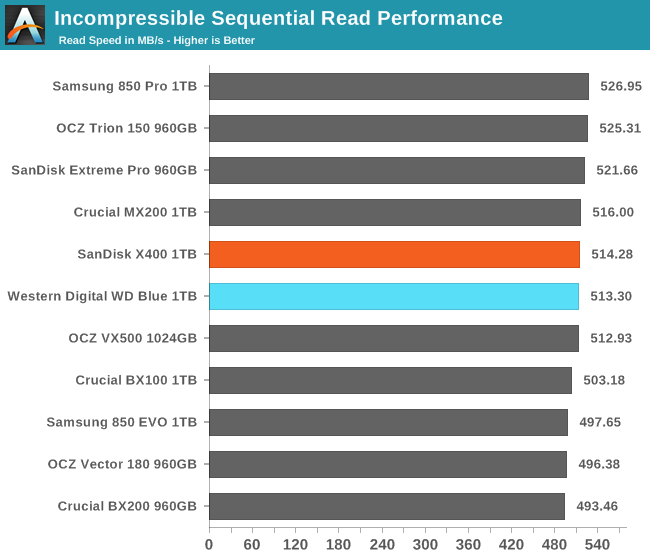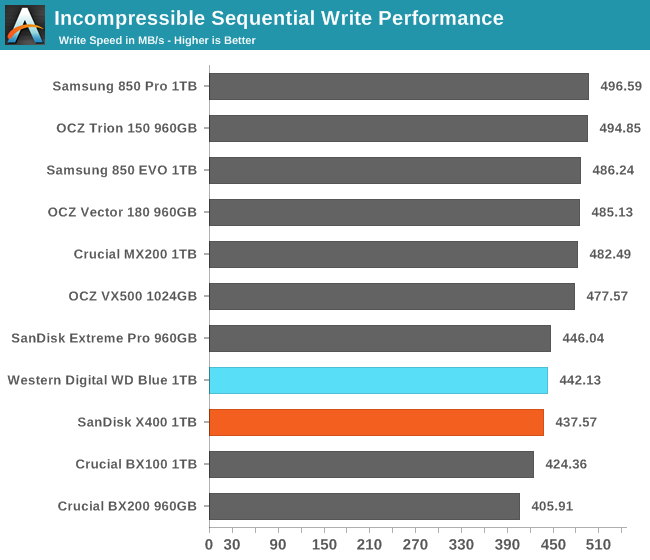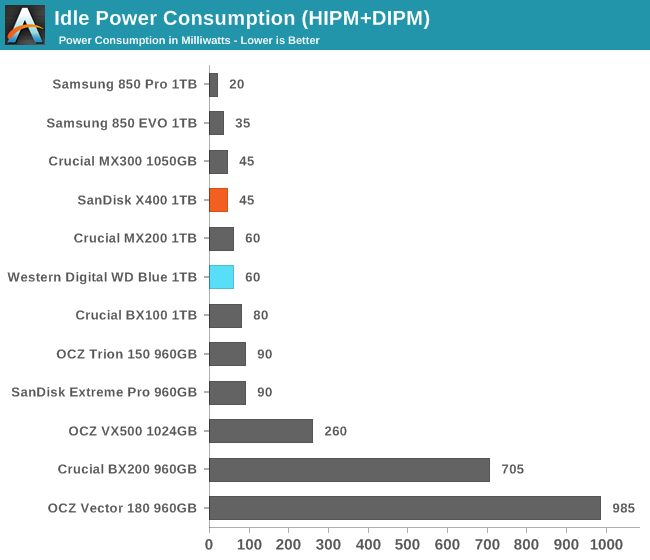The Western Digital Blue (1TB) SSD Review: WD Returns to SSDs
by Billy Tallis on October 11, 2016 8:00 AM EST- Posted in
- SSDs
- Storage
- Western Digital
- SanDisk
ATTO
ATTO's Disk Benchmark is a quick and easy freeware tool to measure drive performance across various transfer sizes.
 |
|||||||||
The WD Blue shows slightly better write speeds on the ATTO test than the SanDisk X400, but both fade a bit in read speed toward the end of the test.
AS-SSD
AS-SSD is another quick and free benchmark tool. It uses incompressible data for all of its tests, making it an easy way to keep an eye on which drives are relying on transparent data compression. The short duration of the test makes it a decent indicator of peak drive performance.


The AS-SSD test seldom shows large differences in performance, and the WD Blue performs almost identically to the X400. The write speed is still a bit on the low side.
Idle Power Consumption
Since the ATSB tests based on real-world usage cut idle times short to 25ms, their power consumption scores paint an inaccurate picture of the relative suitability of drives for mobile use. During real-world client use, a solid state drive will spend far more time idle than actively processing commands. Our testbed doesn't support the deepest DevSlp power saving mode that SATA drives can implement, but we can measure the power usage in the intermediate slumber state where both the host and device ends of the SATA link enter a low-power state and the drive is free to engage its internal power savings measures.
We also report the drive's idle power consumption while the SATA link is active and not in any power saving state. Drives are required to be able to wake from the slumber state in under 10 milliseconds, but that still leaves plenty of room for them to add latency to a burst of I/O. Because of this, many desktops default to either not using SATA Aggressive Link Power Management (ALPM) at all or to only enable it partially without making use of the device-initiated power management (DIPM) capability. Additionally, SATA Hot-Swap is incompatible with the use of DIPM, so our SSD testbed usually has DIPM turned off during performance testing.


The WD Blue uses a few milliwatts more at idle than the X400. In the slumber state this is not a problem and the WD Blue's power draw is about average. The active idle power draw is a bit on the high side given that the MX300 draws about two thirds what the WD Blue draws when both drives use the same controller and DRAM.










75 Comments
View All Comments
Arbie - Tuesday, October 11, 2016 - link
I agree with another comment. Why is the Mushkin Reactor 1TB not in the charts for recent SSD reviews? At $230 it's cheaper than many, is MLC, and overall seems like a great buy. You reviewed it but then seem to have forgotten it.DanNeely - Tuesday, October 11, 2016 - link
I'm a bit puzzled by the performance consistency numbers here. In them the WD Blue 1TB seems to be consistently faster than the Sandisk X400 1TB before reaching steady state and about the same speed once it hits that point; but in almost all the other benches the Sandisk scores higher.Billy Tallis - Tuesday, October 11, 2016 - link
The drive is completely filled once before the random write consistency test, which runs at QD32. Most of the other IOmeter scores are averages of low queue depths, and the random write test on page 6 is limited to a 16GB test file on an otherwise empty drive. Whatever effect caused the WD Blue to have lower peak performance is more significant for the shorter test, while for the consistency test the fact that the WD Blue has more spare area to start with than the X400 is a bigger factor.kmmatney - Tuesday, October 11, 2016 - link
I bought a SanDisk Ultra II 960GB drive about a year ago for around $200, and it's still close to that price ($219 at the moment). It's the one with SLC cache - I use it in my everyday work computer, as my OS drive, and I typically run 1-2 virtual machines as well. So I push it fairly hard for a consumer SSD, and it still runs great - no complaints at all, and I'd recommend it for the price.Michael Bay - Thursday, October 13, 2016 - link
Same experience here. In a few weeks it will be a year of use for me, and if Sandisk utility is to be trusted, it`s only 1% worn.mapesdhs - Friday, October 14, 2016 - link
It's a pity the X300 is not available anymore, it had very good consistency and at one point was cheaper than many budget models.Shadowmaster625 - Tuesday, October 11, 2016 - link
It is amazing that they fit all that on one side of the board without so much as a capacitor on the back...LordConrad - Tuesday, October 11, 2016 - link
Sorry, I refuse to buy a SSD that uses TLC planar NAND.TheinsanegamerN - Tuesday, October 11, 2016 - link
why? these have higher write endurance then some MLC drives.MrCommunistGen - Tuesday, October 11, 2016 - link
That was quick - WD releasing an SSD under their own name. Sure it is a warmed over X400, but as the performance numbers indicate they didn't just slap a sticker on it... which leads to my next comment.When I read the opening of the article I was pretty excited. X400 with a bit more overprovisioning. I was expecting to see extra performance (even if only a little) along with the endurance. I guess not. Oh well.